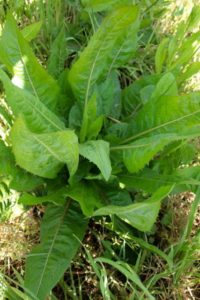Chicory (Cichorium intybus) has beautiful bright, pale blue flowers
on stems that can reach 120cm tall. It is not flowering now in July but I am still using the leaves, which are lobed, deep green and look like large dandelion leaves, and taste as bitter (the leaves can also be rounded, with a red tinge and not lobed). Bitter however, isn’t all bad, in fact it is very good for us and has a tonic effect on the liver and gall bladder and it primes the digestive system, triggering the release of bile and enzymes so that food is well processed. A lot of cultures around the world know this e.g. in Greece where they steam greens, dress them with lemon, olive oil and salt in a dish called ‘Horta vlasta’ to aid digestion.
In its first year chicory leaves grow in a rosette low to the ground, then in the second year they send
up the tall flower stalk. The distinctive blue flowers either have very short or no stalks in clusters of two or three but only one is out at a time. It flowers from Dec-Mar. Gather the seeds and you can grow it in your garden.
Chicory is a perennial that likes cultivated land, roadsides or neglected, waste places. It is increasingly being sown in pasture as drought tolerant fodder for animals. It comes from Europe where the French and Belgians eat huge amounts, West Asia and North Africa.
You can make ‘chicons’ from Chicory. These are produced by forcing the roots in warmth and darkness, which blanches the new growth, so it is white and not bitter.
The roots also make a coffee substitute (no caffeine though). This is nothing new it’s been enjoyed since the 17th Century. As I do with Dandelion you dig the roots in autumn, clean them, cut into small pieces, dry them or immediately lightly roast in a cool oven until completely dry. Either grind or leave whole and boil a tablespoon in a cup of water for five minutes and enjoy a warming drink.
Besides being a valuable digestive and nerve tonic Chicory is a rich source of Vitamin C, Vitamin A, Vitamin E, Vitamin B9 and B12 and contains the minerals calcium and phosphorus. It also contains essential fatty acids.
Grow chicory or wild source it and put a handful of leaves in your smoothie. The flowers will be a
beautiful decoration for your salads and the leaves can be cut up and added to salad also. I had a lot of fun creating an unusual breakfast the other day. I made scrambled eggs with weeds – bitter cress, chickweed, nasturtium on a bed of diced chicory leaves with my own home grown Austrian hull-less pumpkin seeds which I toasted. I also lightly boiled shining spleenwort (Asplenium oblongifolium) fronds. Māori ate this as a vegetable and called the new koru fronds of this fern and the hen and chicken fern Pikopiko.








I was never quite sure what chicory looks like, so now you have inspired me to find some and try it out. The blue flower is lovely. I have eaten Pikipo though and it’s become a favourite spring treat.
HI Juliet, that is fabulous that you now feel inspired to find some chicory. I’ve noticed that ferns send up new fronds in winter – I guess because it’s wetter then. Glad you enjoy them. Thanks so much for writing.
Sorry that was oxalis